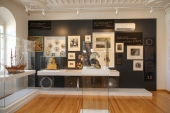The Messolonghi Byron Society presents its new Museum for Lord Byron and Philhellenism
On 27 June 2021, the inauguration of the of the Messolonghi Byron Society’s Museum for Lord Byron and Philhellenism, took place.
In the inaugural exhibition the National Historical Museum, in collaboration with the Byron Society of the Sacred City of Messolonghi, presents a flashback to the Greek Revolution 1821 with emphasis on the events that took place in Western Central Greece.
The exhibition is called: "Revolution '21 Reframed".
Following the main axes of the bicentennial exhibition in Athens, dozens of objects from the collections of the National Historical Museum and documents from the Archives of the Historical and Ethnological Society of Greece, commemorate people and events of the period extending from the outbreak of the Revolution to the liberation and the first years of modern Greece.
The exhibition’s narrative course begins with the conditions that shaped the outbreak of the Revolution. An interactive exhibit of the Map of Greece by Rigas Velestinlis provides information about this unique map and its creator, the movement of the Modern Greek Enlightenment and its representatives, the Diaspora of the Greeks, and the spread of the ideas of the Enlightenment and Liberalism.
Next comes special mention of the revolutionary movements of Europe and especially of the establishment of secret companies, such as the Friendly Society (Filiki Etaireia), which prepared the ground for the Greek struggle. The outbreak of the Revolution in the Danube hegemony and in the Peloponnese follows the beginning of the Struggle in Aitoloakarnania.
Topics such as the methods of war on land and sea, sieges, daily life, politics, and diplomacy are presented in this section. Special mention is made of the heroic 1826 Exodus of the defenders of Messolonghi and the impact it caused on both Greeks and Philhellenes abroad.
The Philhellenic movement and its most famous representative, Lord Byron, are presented in a separate room, with displays related to the philhellenic committees and to the press (through a special interactive exhibit). Here a triptych shows Lord Byron as Poet, as Rebel and as Myth.

